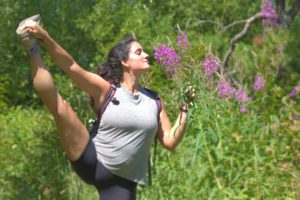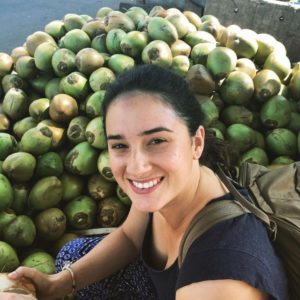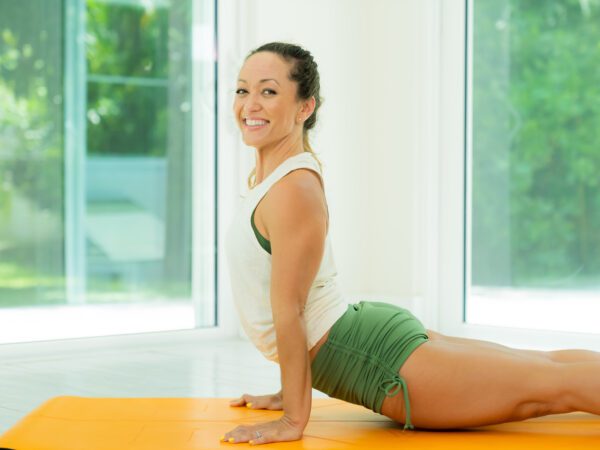I attribute yoga taking over my life to the moment I started practicing Ashtanga yoga mysore style at Miami Life Center. It affected everything, not just the 90 minutes in class. I fell hard (still falling) for this practice and mysore style was a gateway to a whole new world. That is, until about 4 months into my new found high. I fell off my bike. Nothing too serious, but enough for me to determine I couldn’t practice yoga until I was fully healed. I fell on my right arm and hurt my elbow so it was difficult to put weight on it, like in downward facing dog. I thought if I can’t downward dog I have no business walking into a mysore room.
I took about 3 months off, more than I probably needed to. Losing the momentum of practicing 3 times a week made it really hard for me to get back to the mat. I’ve come across students with similar experiences. Getting back on the mat after stepping away for the first time is sometimes harder than coming to the mat in the first place. You would think the opposite, especially after experiencing the life shifting results from a regular practice, that you’d come running back.
If you want to know the benefits of practicing yoga, stop practicing. I’m pretty sure I got that one from David Swenson. But its so true! It points to the slow subtle shifts that yoga creates on a deep level, which then slowly work their way to the surface. You won’t notice how much has changed from one day to the next, but if all of a sudden you stop practicing and those yoga benefits stop making an appearance in your life, the sharp contrast in how you feel and show up in the world will tell you. Yoga works in quiet sometimes mysterious ways.
When I was off the mat those months, I felt the tamas, apathy and heaviness coming back into my body and mind. I was more emotional, getting lost in sadness and doubt (my go to’s). The crazy part was that before yoga I never thought of these things as the lack of yoga, but as my nature, a part of who I was and never considered living without them. It was a big shift for me. I now saw those physical, mental and emotional states as changeable by a yoga practice.
My practice had become a space for me to tune in, which I soon realized allowed me to show up as a better and more present person for the rest of my day. I didn’t realize at the time that I didn’t need to do a downward facing dog in order to have that. But the mysore room and the teacher provided me with a clearly defined space and time to tune in. And most importantly a method and path to support me through that process. I didn’t know how to move through this process alone, much less that I was so eagerly searching for a path most of my life. When I found this path, I sank into it without fully realizing that I had finally found what I was searching for. Having a teacher, a class holding me accountable, expecting me to show up for that space was really important for me at the beginning. Which makes this less about blaming myself for stepping away when I was hurt, and more about understanding and compassion for my journey as a beginner.
When I got back into the mysore room 3 months after I fell off my bike, I felt like I had taken 2 steps back. Starting up again took so much effort, so much tapas and fire to burn through the stagnation that had taken over. It was an important part of my journey, going through that physical, mental and emotional effort and discomfort. Once I got through it, the daily ritual of this practice and tuning in was further ingrained in me. Since then I’ve had unbroken regular practice, nowadays 6 days a week for asana.
Fast forward 4 years and I run into a shoulder injury. There was pain when I lifted my arms over my head. I couldn’t do the first movement in Ashtanga yoga! Which of course brought on all the reactions – sadness, frustration, doubt whether I would even practice yoga again. But this time I knew better. I wasn’t going to stop coming to the mat. My practice needed to drastically change from intermediate and part of third series, to heavily modified standing postures. I went from practicing asana for 90 minutes to 20. At this point I realized those 90 minutes were really useful as it took me some time of being on the mat to drop down to the undercurrent. So I looked for other tools to keep me on the mat each day a bit longer than 20 minutes.

I found pranayama (the practice of controlling the breath) through one of my teachers, Mark Linksman. It become my main practice while my shoulder was healing. It was such a beautiful time for me as a yoga practitioner. I continued healing the body through minimal movement, not allowing stagnation to take over and I opened up to a new pathway into the practice of yoga, into focusing inwards. Pranayama is incorporated in the Ashtanga system, but to practice it on its own gave me a closer look into the self-transformational power of the breath. I explored more precise ways of working with it that could be translated to deepen an asana practice.
It’s so interesting to notice how as I spend more time on the mat, my ideas about what I think is right or wrong changes. The context of my practice changes because my perspective gets a bit broader. It’s as if I can look in from a further stance and get a more complete view of Ashtanga Yoga, or yoga in general for that matter. I imagine it’ll be like this for the long haul of this path – I’ll keep taking another step back, and keep seeing pieces I was blind to before because they weren’t yet in my view.
This time, as soon as my shoulder healed I was there, present and ready to slowly move back into a longer asana practice. This time without the heaviness I had the first time coming back from an injury. I had maintained a practice so I never really left. Creating a practice with a different form allowed me to better understand through firsthand experience the purpose of yoga, regardless of the tools used. It wasn’t to perfectly execute a shape with our bodies but to create a space to observe ourselves, to sit in awareness. Lucky for us we’ve been given more than one way of doing this, teachings that have been passed down through many generations, through lineage.
I was also given an opportunity to witness the healing potential of the primary series of Ashtanga yoga. Moving slowly through heavily modified standing postures and then into primary series little by little facilitated my healing process, coupled with some physical therapy exercises. I wasn’t doing the traditional full expression of primary series, but to me is was complete and perfect. I had the opportunity to revisit the foundations and refine basic technique. It’s since then become a big focus in my practice – continuously going back to the basics. While I was healing it helped me establish movement patterns that more efficiently built strength and flexibility while doing a very beginner practice. Mentally, I learned to tap into a beginner’s mind, looking at something for the hundredth time with a unbiased perspective. As I moved back into a more advanced practice, my body felt good and strong because of the time I spent more intimately understanding basic movements.
I often see students get caught up in the external conditions set for the sequence, holding on to them as truth, thinking if it weren’t followed perfectly it meant they weren’t practicing Ashtanga yoga. The context of Ashtanga yoga is much broader than the postures – another lesson I picked up from these experiences with injury. The postures are there as tools for a more holistic and spiritual purpose. They bring us into our bodies, something tangible to feel what’s present. They give us a single point to focus on, and they give us a mirror to observe ourselves by. And yes the conditions set to execute an asana are important, such as place your hand here, breath in here, but they can be accommodated to work with a student’s situation, like a physical limitation for example, and still maintain the intention of yoga.
We can expand the context of yoga by modifying a posture, incorporating seated breathing or seated meditation, staying in one posture for 10 minutes, the list goes on. There are different doorways into yoga and therefore the pathways along the way may look different, in the same way that my personal journey through this practice will look different than yours.
I had two different experiences with injury and came out with my own lessons and conclusions, which I get to share with you here. Not to tell you what to do but to let you know that there are different paths within this path and it’s important to find your own way. I’ve used the experiences and knowledge of others to help inform what and how I choose to explore. To then evaluate and integrate the lessons learned from my own personal experience. The result is as many expressions of yoga as there are humans, and that’s a beautiful thing.

Practice LIVE on Omstars with Monica Arellano
Monica Arellano is a Level 2 Authorized teacher in the Ashtanga Yoga Method; a formal blessing received by her teacher R. Sharath Jois in Mysore, India. She first connected to the practice of yoga in 2010, looking for a more peaceful way of being. When she found her way to Miami Life Center in 2014 she began a regular Ashtanga Yoga practice and soon after completed a 2 year apprenticeship program under Tim Feldmann. Today she continues to practice, teach and travel regularly to Mysore, India to learn yoga directly from the source. Monica’s teachings are informed by the knowledge carried on from her teachers and the first-hand experience from her daily asana and meditation practice. Her classes emphasize the breath, alignment, and methods of concentration; in hopes of exploring the deeper experience of asana and the resulting expression in each student’s unique and mind. In this space, she believes we can deconstruct unhealthy patterns, facilitate healing on many levels, and find our way back to the most honest version of ourselves.
This blog was originally posted on monicarellano.com










